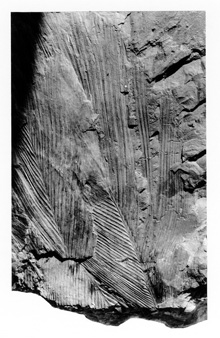Common menu bar links
When archeological material is uncovered, established protocols ensure that important specimens and data are secured. Few provinces in Canada, however, have established similar protocols for paleontological material. The paleobotanical treasure, here, was saved by the uncommon action of an individual worker

On a hot day in early August 1996, bulldozer operator John Bell was busy moving large chunks of blasted Upper Cretaceous sandstone along the approach to the new ferry terminal at Duke Point, south of Nanaimo on Vancouver Island. He spotted something peculiar on the underside of a massive piece of grey rock. It was not a fracture -- the closely spaced lines extending from a central axis were more reminiscent of a gigantic feather. It was definitely unusual. So, instead of adding this rock to those destined for crushing, Bell lifted the basket of the bulldozer up 3 metres and set the rock at the edge of the roadcut, right in front of the Cranberry Arms Inn. A stunning plant fossil could then be seen -- a palm frond nearly 2 metres long, possibly the largest fossil leaf ever found in Canada.
Other plant fossils were also present -- leaves with the veins in relief, conifer foliage, delicate fern fronds and, most surprising of all, exquisitely preserved flowers. The press was alerted and a spate of articles in Nanaimo and Victoria newspapers followed (one predictably referred to these plant fossils as "dinosaur salad"). Soon, amateur paleontologists descended on the site. And, in what can only be described as a rescue mission, fossiliferous blocks were snatched, literally in front of working bulldozers, to prevent their ending up as crushed stone.
These king-sized Cretaceous palm fronds 80 million years old are appropriately identified as Phoenicites imperialis. Each frond consists of a stout gradually tapering rachis (a main axis of a compound leaf) up to 2 m long. The rays form a continuous sheet of 1 cm-wide plications that have the appearance of a fine venetian blind. In life, these leaves must have been leathery and tough. The generic name alludes to a similarity to the living date palm, Phoenix, but it is unlikely that they are closely related.

